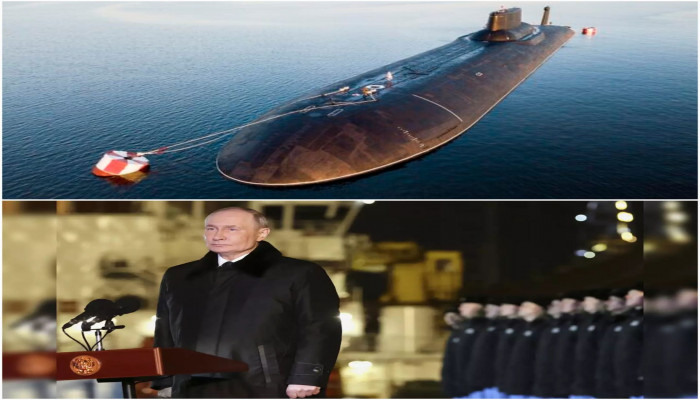Putin oversees launch of nuclear submarine 'Perm' armed with hypersonic zircon missiles
- In Reports
- 04:36 PM, Mar 28, 2025
- Myind Staff
On Thursday, Russian President Vladimir Putin oversaw the launch of a nuclear-powered submarine armed with hypersonic Zircon missiles, which can travel several times the speed of sound. According to the ASS news agency, the event occurred in Murmansk, Russia’s northern region. The submarine, named 'Perm,' is a fourth-generation multipurpose nuclear-powered vessel and the sixth in the Project 885/885M Yasen-class series built at the Sevmash Shipyard for the Russian Navy. Its construction began on July 29, 2016.
Putin praised the submarine’s launch, emphasising it would strengthen Russia’s naval security and safeguard national interests, particularly in key areas like the Arctic. The move comes as Moscow expands its military capabilities amid ongoing global tensions.
At the core of this advanced weaponry is the Zircon hypersonic missile, known for its exceptional speed and accuracy. Added to Russia's military arsenal in early 2023, the Zircon was primarily developed as an anti-ship missile but has also been used in strikes on Ukrainian cities. Media reports show it was first deployed against Ukraine in February 2024. The missile can travel approximately 8-9 Mach, or around 10,000 kilometres per hour, and carries warheads weighing between 300 and 400 kilograms.
The Russian Navy maintains one of the world's largest and most potent submarine fleets, consisting of approximately 64 vessels. A key element of its strategic deterrence is its fleet of 16 nuclear-powered ballistic missile submarines (SSBNs), which play a vital role in Russia's defence strategy.
The Russian Navy's submarine fleet consists of 23 diesel-electric attack submarines (SSKs), 16 ballistic missile submarines (SSBNs), 14 nuclear-powered attack submarines (SSNs), and 11 nuclear-powered cruise missile submarines (SSGNs).
The Russian Navy operates several classes of submarines, each serving a distinct role. The Borei-class is a key part of Russia’s strategic deterrence, equipped to carry multiple ballistic missiles. These submarines measure 170 meters long and can reach up to 29 knots underwater. The Yasen-class nuclear-powered cruise missile submarines (SSGNs) are designed for combat operations, including engaging enemy ships, submarines, and land-based targets. They are 119.8 meters long and can travel at a submerged speed of 31 knots. The Delfin-class submarines, built between 1985 and 1992, have a length of 167 metres and a maximum underwater speed of 22 knots. The Kalmar-class submarines are 155 metres long and can operate up to 25 knots when submerged. Lastly, the Shchuka-class submarines measure 107.2 meters in length and can travel at 30 knots underwater. These vessels can also carry up to thirty-six mines as an alternative to torpedoes.
After facing financial difficulties following the Soviet Union's collapse, Russia has made significant strides in modernising its submarine fleet. Since the 1990s, several large-scale projects have been launched to strengthen its naval capabilities. One such project began in 1993 with the construction of the Yasen-class submarine Severodvinsk (K-885), though financial and technical setbacks delayed its commissioning until 2014. To upgrade its fleet, Russia plans to replace older SSNs and SSGNs with the more advanced Project 885-M Yasen-class submarines. The second submarine of this class, Kazan, was launched in 2017 and joined the Northern Fleet in 2021, further bolstering the country's naval strength. In June 2019, Russia signed an agreement with Sevmash to build two more nuclear-powered submarines under the Project 885-M Yasen-class.







Comments